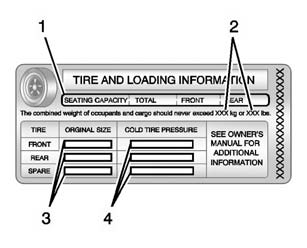Chevrolet Sonic Owner's Manual: Tire and Loading Information Label

A vehicle-specific Tire and Loading Information label is attached to the vehicle's center pillar (B-pillar). The Tire and Loading Information label shows the number of occupant seating positions (1), and the maximum vehicle capacity weight (2) in kilograms and pounds.
The Tire and Loading Information label also shows the tire size of the original equipment tires (3) and the recommended cold tire inflation pressures (4). For more information on tires and inflation see Tires and Tire Pressure.
There is also important loading information on the Certification label. It tells you the Gross Vehicle Weight Rating (GVWR) and the Gross Axle Weight Rating (GAWR) for the front and rear axle. See “Certification Label” later in this section.
 Vehicle Load Limits
Vehicle Load Limits
It is very important to know how much weight the vehicle can carry. This weight
is called the vehicle capacity weight and includes the weight of all occupants,
cargo, and all nonfactory-installed ...
 Steps for Determining Correct Load Limit
Steps for Determining Correct Load Limit
1. Locate the statement "The combined weight of occupants and cargo should never
exceed XXX kg or XXX lbs." on your vehicle’s placard.
2. Determine the combined weight of the driver and ...
Other materials:
Remote Keyless Entry (RKE) System Operation
The RKE transmitter may work up to 60 m (195 ft) away from the vehicle.
Other conditions can affect the performance of the transmitter. See
Remote Keyless Entry (RKE) System.
RKE without Remote Start
Shown
The following buttons are on the transmitter:
...
Instrument Panel Fuse Block Access Hole Cover Replacement (With AAL)
Instrument Panel Fuse Block Access Hole Cover Replacement
Callout
Component Name
1
Instrument Panel Fuse Block Access Hole Cover
Procedure
Grasp the lower edge of the fuse block cover and pull outward disengaging ...
Airbag Roof Side Rail Module Replacement - Rear
Airbag Roof Side Rail Module Replacement - Rear
Callout
Component Name
Warning: In order to prevent SIR deployment, personal injury,
or unnecessary SIR system repairs, do not strike the door or the door
pillar in the ...
0.0047
